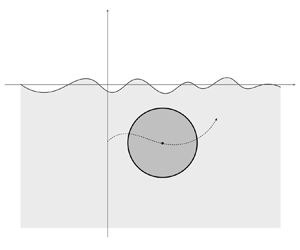No CrossRef data available.
Article contents
Impulsive acceleration of a circular cylinder under free surface
Published online by Cambridge University Press: 14 August 2023
Abstract

A present paper generalizes the work of Tyvand & Miloh (J. Fluid Mech., vol. 286, 1995, pp. 67–101) on the problem of the free surface flow generated by a submerged circular cylinder moving impulsively with constant velocity to the case of a cylinder moving with both initial velocity and acceleration. The nonlinear small-time asymptotic solution for the velocity potential, free surface elevation and hydrodynamic pressure force is calculated analytically in bipolar coordinates for a cylinder of arbitrary radius. The analytical solution is obtained to the leading order of nonlinear interaction between initial impulsive velocity and initial impulsive acceleration directed at arbitrary angles. In the special case of the motion with constant acceleration, the complete fourth-order free-surface flow problem is solved and the associated second-order hydrodynamic force is computed. The leading-order contributions to the free surface elevation due to the constant velocity and constant acceleration are compared for finite rectilinear cylinder displacements. The role of constant acceleration consists of two contributions to the leading nonlinear terms, where the amplitude of the first one is 25 % below the case of constant velocity while the amplitude of the other exceeds it by 50 %.
Information
- Type
- JFM Papers
- Information
- Copyright
- © The Author(s), 2023. Published by Cambridge University Press


